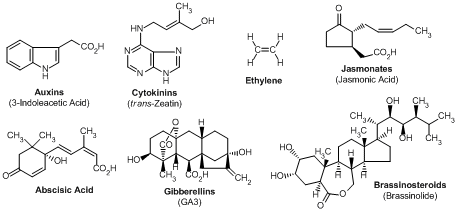Product Document Searching Made Easy by 2D Code! | TCI Chemistry News November 2025 | [Product Highlights] Hydrosilane Useful for Hydrogenation... | Various analytical charts can be searched on each product detail page and Product Document Search (The kinds of analytical charts differ by product)
Maximum quantity allowed is 999
请选择数量
植物生长调节剂
A typical example of plant growth regulator is a plant hormone. Plant hormones are the collective term for compounds produced in minute amounts by plants to regulate their own physiological functions. To date, seven natural plant hormones have been discovered: auxins, cytokinins, ethylene, jasmonates, abscisic acid, gibberillins and brassinosteroids (Figure 1). Unnatural plant growth regulators or plant growth inhibitors are also included in this page.

Auxins
Historically, auxins were first discovered as substances which showed phototropism. To date, it has been revealed that they play numerous roles such as initial development, budding, root growth development, growth of flower parts and cell division. Natural auxins are 3-indoleacetic acid, 3-indolebutyric acid and phenylacetic acid. Some unnatural synthetic compounds also exhibit the same activities.
Cytokinins
Cytokinins are regarded as substances which stimulate cell division, shoot initiation and bud formation, when addition auxins are added. Typical structure features are adenine with an isopentenyl unit at N6 position, or with an isopentenyl unit with the methyl terminus being hydroxylated.
Ethylene (Precursor)
Jasmonates
Jasmomates have a distinct fragrance and are biosynthesized from linolenic acid, an unsaturated fatty acid. They inhibit growth in adverse conditions, and stimulate tuber formation. They promote senescence of leaves, suppression of fruit growth, and the induction of tuber formation in potatoes.
Abscisic Acids
Abscidic acid is occasionally classified as a sesquiterpene, however, it is biosynthesized from a carotenoid (C40) precursor. It stimulates the closure of stomata in the absence of water and induces seeds to synthesize storage proteins. It is also released when a plant experiences stress, as in lack of nutrition, pests, root distress, or disease.
Gibberellins
Other Plant Growth Regulators
References
- a) Review:
- L. Taiz, E. Zeiger, in Plant Physiology, 4th ed., Sinauer Associates, Sunderland, 2006.
- b) R. Arteca, in Plant Growth Substances:
- Principles and Applications, Chapman & Hall, New York, 1996.

